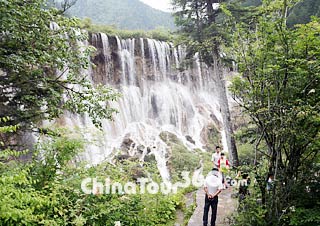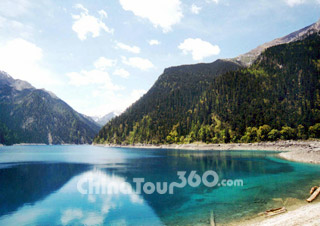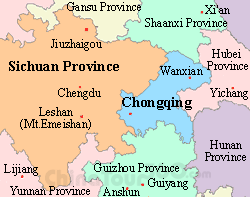 A Waterfall in Jiuzhaigou
A Waterfall in Jiuzhaigou Tibetan Dance Performance
Tibetan Dance Performance Jiuzhaigou Valley
Jiuzhaigou Valley
![]() Facts
Facts
Phone Code: 0837
Postal Code: 623400
Area: 5,290 sq km (2,042 square miles)
Population: 66,246
Nationalities: Tibetan, Qiang, Hui, Han
Neighboring Areas: Wen, Zhouqu, and Diebu Counties in Gansu, and Ruo’ergai, Pingwu, and Songpan Counties in Sichuan
Location: Jiuzhaigou County is located on the plateau in the north of Sichuan Province, at the border between Sichuan and Gansu provinces. Its longitude lies between 103°27′- 104°26′E, and the latitude is between 32°53′- 33°43′N.
Physical Features: High mountains cover most of Jiuzhaigou County, and plateaus and platforms are scattered among mountains. The county lies at the transitional zone between Sichuan basin and Qinghai-Tibet plateau, so the southern area is higher than the north. The unique karst landform makes it a hot scenic spot in China.

![]() History:
History:
Jiuzhaigou, formerly named Nanping, is a county in the Ngawa (Aba) Tibetan and Qiang Autonomous Prefecture. Archeologists have found relics dating from the Neolithic Period, some 5,000 years ago in the area. It has always been a home to some ethnic groups, including Tibetan and Qiang people. During the reign of Emperor Yongzheng of the Qing Dynasty (1644 - 1911) Nanping was established in current Jiuzhaigou. In the year of 1998, it was renamed Jiuzhaigou County.
![]() Attractions:
Attractions:
Jiuzhaigou County is bestowed with gorgeous natural scenery. There are the Jiuzhaigou Valley Scenic Area, Ganhaizi Scenic Resort Area, and Shenxian Pool Scenic Area. Located at a “Y” shape valley in the county, Jiuzhaigou Scenic Area boasts plenty of waterfalls, limpid streams, colorful forests, snow mountains, and unique Tibetan customs. Many other attractions here reflect the special ethnic flavors, such as the Tibetan architecture of the Dalu Fortress, White Horse Tibetan Cultural Garden, and the Tibetan monasteries Zharu, Northeast, and Daji Temples. Typical Han style temples, Wind City (Fengcheng) and Chaoyang Temples are also popular attractions in Jiuzhaigou.
![]() Transportation
Transportation
![]() Air: The major means of transportation getting to Jiuzhaigou by air. The Jiuzhaigou Huanglong Airport now operates regular flights to and from Beijing, Shanghai, Hangzhou, Xian, Chongqing and Chengdu.
Air: The major means of transportation getting to Jiuzhaigou by air. The Jiuzhaigou Huanglong Airport now operates regular flights to and from Beijing, Shanghai, Hangzhou, Xian, Chongqing and Chengdu.
![]() Train: Currently, there is no direct rail link to Jiuzhaigou. The Chengdu-Lanzhou Railway which makes a stop at Jiuzhaigou is now under construction and will be put into use in the year of 2016.
Train: Currently, there is no direct rail link to Jiuzhaigou. The Chengdu-Lanzhou Railway which makes a stop at Jiuzhaigou is now under construction and will be put into use in the year of 2016.
![]() Bus: Visitors can take a long-distance bus from Chengdu, Lanzhou, or Chongqing to Jiuzhaigou.
Bus: Visitors can take a long-distance bus from Chengdu, Lanzhou, or Chongqing to Jiuzhaigou.
![]() Weather
Weather
Jiuzhaigou has a mild monsoon climate with a long winter and short summer. The average annual temperature is 12.7 °C (54.9 °F). July is the hottest month with a mean temperature of 16.8 °C (62.2 °F), while January is the coldest month with an average temperature of -3.7 °C (25.3 °F). May to September is the rainy season, and from October to April the area is covered by snow.
![]() Dining and Shopping
Dining and Shopping
The local snacks are mostly Tibetan flavor. Ya Tea is a kind of special tea growing in Ya’an, Sichuan. The Tibetan people use it to make the Tibetan butter tea. Boiled potato mash is also one of most popular food in Jiuzhaigou. The potato mash is not just normal potato mash, as the boiled potatoes will be pounded into a glutinous mash which tastes better than the usual mash. Noodles or steamed buns made of buckwheat flour, barley wine, yoghourt, butter tea, and dried beef are also local specialties.







